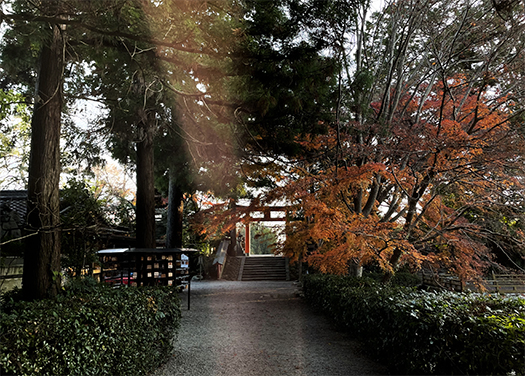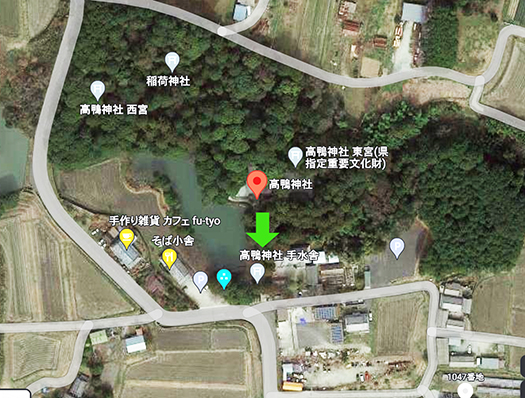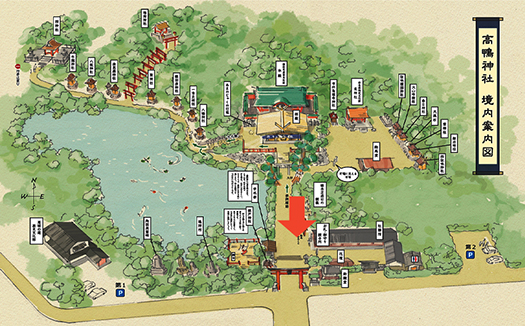
わたしは別にオカルトに興味がある人間ではありません(笑)。ただ最近は奈良県の古都地域、飛鳥とか纏向・桜井とか橿原などの土地の魅力に強く惹かれてきております。たしかに古代からの日本国家の祖型がそこにあって、文書では明確ではないけれど考古的には確実性が高い痕跡に魅了されてきていることは、ブログを見ていただいているみなさんにはご理解いただけることと思います。
そういうなかで数次訪れているのが奈良県御所市鴨神の金剛山東山麓にある神社・高鴨神社。以下社伝から要旨抜粋。
〜弥生中期、鴨族の一部は葛城川岸辺で水稲農耕をはじめ一般に本社を上鴨社、御歳神社を中鴨社、鴨都波神社を下鴨社と呼んだ。このほか鴨一族はひろく全国に分布しその地で鴨族の神を祀った。賀茂(加茂・賀毛)を郡名にするものが安芸・播磨・美濃・三河・佐渡の国にみられる。中でも京都の賀茂大社は有名で本社はそれら賀茂社の総社にあたる。・・・この地は大和の名門豪族・鴨一族発祥の地で本社はその鴨族が守護神として祀った社の一つ。『延喜式』神名帳には「高鴨阿治須岐詫彦根命(たかかもあじすきたかひこねのみこと)神社」とみえ官幣に預かる名神大社。最高社格をもつ神社。〜
御所の街並みは非常に興味深くて参観時、道に迷ってたどりついた神社(笑)。なんですが池越しに美しい社殿のたたずまいを見てすっかりゾッコンになった。その後いろいろなご縁も生まれたりしております。この高鴨神社で上の写真のような「光のスジ」を体感した。拝殿・本殿を参観後、鳥居方向に参道を歩いていてなにげに写真を取ったのですが、このような光線が感じられ写真にもしっかり映り込んでいる。(この写真は別テーマ記事でも使用済み)


神社のHPには以下のような記述。「カモはカミと同源でありカモすという言葉から派生。「気」が放出している様子を表しています。当神社の神域は鉱脈の上にあることも重なり、多くの「気」が出ていることでも有名。夏場に参詣すると涼しく感じられるのはその為。気は身体にたいへん良く、ぜひ神域を巡られて神様の「気」を受け、心身共によみがえられることをお祈り申し上げます。」
この光線が撮影されたのは冬至に近い時期の午後2−3時ころ。参道は本殿・拝殿を背にしてまっすぐ真南に位置する鳥居方向に向かって顕現した。なので季節的に太陽光の自然光線とは思えない。もし「木漏れ日」であれば、写真右側からのスジになるはずなのです。そのような「乱反射光」を生み出すような対象物は周辺には確認できない。わたしはこのHPの文章に書かれている鉱物資源による「発光現象」の科学知見は持っていないので、いまのところ不明、ナゾとなっています。しかし伝承で石見銀山周辺では朝鮮から来た鉄鉱石資源技術者たちがその独特の発光現象をはるかな海上・船から見てから現地を探索し鉱脈を発見したという説を読んだ記憶がある。・・・
なかなか神秘的な気分を感じて面白くワクワクはさせられている(笑)。読者の方でなにか理解の助けになる情報がありましたら、ぜひお知らせください。よろしく。
English version⬇
Luminescence phenomenon over a vein at Takagamo Shrine, Gosho, Nara Prefecture?
This shrine area is located on a mineral vein and is famous for its large amount of “chi” (energy). Is it possible for such mineral resources to react to light? I wonder. I wonder…
I am not a person who is interested in the occult (laugh). However, I have recently been attracted to the ancient capital regions of Nara Prefecture, such as Asuka, Kumamukai, Sakurai, Kashihara, etc. It is true that the ancient ancestors of the Japanese nation existed there. I am sure that the ancient ancestors of the Japanese nation existed there, and I am fascinated by the traces that are not clearly documented but are highly archaeologically certain, as you can understand from my blog.
One such shrine I have visited several times is Takagamo Shrine, located at the eastern foot of Mount Kongo in Kamogami, Gosho City, Nara Prefecture. The following is an excerpt from the shrine’s biography.
〜In the middle of the Yayoi period, a part of the Kamo clan began rice farming along the banks of the Katsuragi River, and generally called the head shrine Kamigamo-sha, the Mitose shrine Nakagamo-sha, and the Kamotonami shrine Shimogamo-sha. In addition, the Kamo clan was widely distributed throughout the country, and the Kamo deities were worshipped at their shrines. The Kamo (Kamo or Kage) clan was also found in the counties of Aki, Harima, Mino, Mikawa, and Sado. Kamo-taisha in Kyoto is the most famous of these, and its headquarters is the head shrine of all Kamo shrines. The head office is one of the shrines enshrined as a guardian deity by the Kamo clan, a prestigious Yamato clan. In the Engishiki, the shrine is named Takakamo Ajisukitakahikone-no-mikoto Shrine, and is a Meishin-taisya (great shrine) under the jurisdiction of the government. The shrine has the highest shrine rank. 〜The town of Gosho is very interesting.
The townscape of the Gosho is very interesting, and when I visited the shrine, I got lost on the way there. I was very interested in the streets of the Gosho, and when I visited the shrine, I got lost on the way there (laugh), but when I saw the beautiful shrine building over the pond, I fell in love with it. Since then, I have been fortunate enough to have many opportunities to visit the shrine. At this Takagamo Shrine, I experienced a “streak of light” like the one in the photo above. After visiting the hall of worship and the main shrine, I casually took a photo as I was walking along the approach to the torii gate. (This photo has already been used in another thematic article)
The shrine’s website has the following description. The word “kamo” is derived from the word “kamosu,” which is the same origin as “kami. It represents the release of chi. The shrine’s sacred area is famous for the large amount of “chi” that is emitted, due in part to its location on top of a vein of ore. This is why it feels cooler when you visit the shrine in the summer. I hope you will visit the shrine to receive God’s “chi” and revive your body and soul.
This ray of light was taken around 2-3 p.m. near the winter solstice. The approach was manifested toward the direction of the torii gate, which is located directly south, with the main shrine and worship hall behind it. So I don’t think it was the natural rays of seasonal sunlight. If it were “sunlight filtering through the trees,” it would have been a swath from the right side of the photo. No object that would produce such “diffuse reflected light” can be identified in the vicinity. I do not have scientific knowledge of the “luminous phenomenon” caused by mineral resources described in the text of this website, so it is unknown and a riddle at present. However, I remember to have read a legend that iron ore resource engineers from Korea saw the unique luminous phenomenon from the sea and ships far from the Iwami Ginzan Silver Mine, and then explored the area and found a vein of ore. It was quite interesting and exciting.
It is quite interesting and exciting to feel a sense of mystery (laugh). If any readers have any information that can help us understand this, please let us know. Thank you in advance.
Posted on 1月 22nd, 2023 by 三木 奎吾
Filed under: 日本社会・文化研究







コメントを投稿
「※誹謗中傷や、悪意のある書き込み、営利目的などのコメントを防ぐために、投稿された全てのコメントは一時的に保留されますのでご了承ください。」
You must be logged in to post a comment.